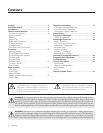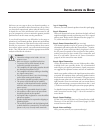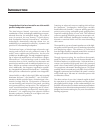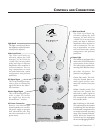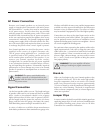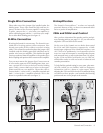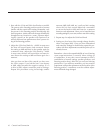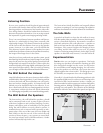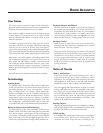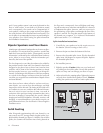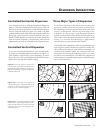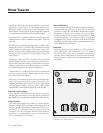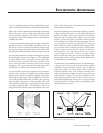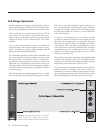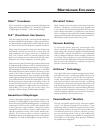
12 Placement
Tilting the Speakers Backwards and Forwards—As the
diagrams show in the Dispersion Interactions section of
this manual (page 15), the vertical dispersion is directional
above and below the stator panel itself. In some instances,
if you are sitting close to the floor, slight forward tilting of
the speakers can enhance clarity and precision.
Imaging—In their final location, your Summit’s can have a
stage width somewhat wider than the speakers themselves.
On well recorded music, the instruments can extend
beyond the edges of each speaker (left and right), yet
a vocalist should appear directly in the middle. The size of the
instruments should be neither too large nor too small, subject
to the intent and results of each unique audio recording.
Additionally, you should find good clues as to stage
depth. Make sure that the vertical alignment, distance from
the front wall, and toe-in is exactly the same for both speakers.
This will greatly enhance the quality of your imaging.
Bass Response—Your bass response should neither be
one note nor should it be too heavy. It should extend to the
deepest organ passages and yet be tight and well defined.
Kick-drums should be tight and percussive—string bass
notes should be uniform and consistent throughout
the entirety of the run without booming or thudding.
Tonal Balance—Voices should be natural and full and
cymbals should be detailed and articulate yet not bright and
piercing, pianos should have a nice transient characteristic
and deep tonal registers. If you cannot attain these virtues,
read the section on Room Acoustics (pages 13–14). This
will give you clues on how to get closer to these ideal virtues.
Final Placement
After the full break in period, obtaining good wall treat-
ments, and the proper toe-in angle, begin to experiment
with the distance from the wall behind the speakers.
Move your speaker slightly forward into the room. What
happened to the bass response? What happened to the
imaging? If the imaging is more open and spacious and
the bass response is tightened, that is a superior position.
Move the speakers back six inches from the initial setup
position and again listen to the imaging and bass response.
There will be a position where you will have pinpoint
imaging and good bass response. That position is the point
of the optimal placement from the front wall.
Now experiment with placing the speakers farther apart.
As the speakers are positioned farther apart, listen again,
not so much for bass response but for stage width and
good pinpoint focusing. Your ideal listening position
and speaker position will be determined by:
• Tightness and extension of bass response
• Width of the stage
• Pinpoint focusing of imaging
Once you have determined the best of all three of these
considerations, you will have your best speaker location.
The Extra “Tweak”
This extra “tweak” may be useful when your speakers
are placed in a dedicated listening room. Use the fol-
lowing procedure and measurements for your speakers
placement to see what can happen to your system’s per-
formance. These formulas will help determine optimum
placement of your speakers to minimize standing waves.
1 Distance from the front wall (in front of the listening
position) to the center of the curvilinear transducer: To
determine distance from the front wall, measure the
ceiling height (inches) and multiply the figure by 0.618
(i.e. ceiling height (inches) x 0.618 = the distance from
the front wall to the center of the curvilinear transducer).
2 Distance from the side-walls to the center of the cur-
vilinear transducer: To determine distance from the
side walls, measure the width of your room in inches
and divide by 18. Next, multiply the quotient by 5 (i.e.
room width in inches / 18 x 5 = the distance from the
side-walls to the center of the curvilinear transducer).
Enjoy Yourself
The Summit is a very refined speaker and benefits from
care in setup. With these tips in mind you will find, over
your months of listening, that small changes can result
in measurable differences. As you live with your speak-
ers, do not be afraid to experiment with their positioning
until you find the optimal relationship between your room
and speaker system that gives to you the best results. Your
efforts will be rewarded.



